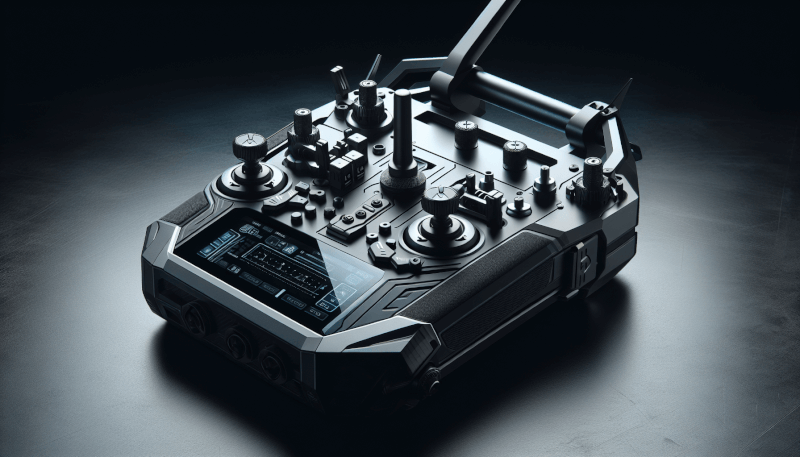Are you an avid RC helicopter enthusiast? If so, you know that having the perfect transmitter is essential for an optimal flying experience. In this article, we will explore some valuable tips that will guide you in selecting the ideal RC heli transmitter. Whether you’re a beginner or a seasoned pilot, these tips will help you make an informed decision and enhance your flying skills. So, let’s dive into the world of RC heli transmitters and unlock the secrets to finding the perfect one for you. Whether you’re a seasoned RC helicopter enthusiast or just getting started in the hobby, choosing the right transmitter is crucial for a satisfying and enjoyable flying experience. With so many options available on the market, it can be overwhelming to determine which one is the best fit for your needs. In this article, we will guide you through the key factors to consider when selecting a transmitter, ensuring compatibility, evaluating features, assessing build quality, determining range and signal strength, considering ease of use, battery life, price range, reviews and recommendations, brand reputation, and upgrade and compatibility options. By the end of this article, you’ll be well-equipped to make an informed decision and find the perfect RC heli transmitter for you.

Compatibility
Check compatibility with your RC helicopter model
When searching for a new transmitter, the first thing you need to ensure is that it is compatible with your specific RC helicopter model. Not all transmitters work with all RC helicopters, so it’s important to do your research or consult the manufacturer’s instructions to verify compatibility. Without this step, you may end up with a transmitter that is unable to communicate with your helicopter, leading to frustration and disappointment.
Consider the frequency range
Another element of compatibility to consider is the frequency range. Transmitters typically operate within a specific range of frequencies, such as 2.4GHz or 5.8GHz. It’s important to choose a transmitter that matches the frequency range supported by your RC helicopter. This will ensure reliable communication between the transmitter and the helicopter, minimizing the risk of interference or signal loss.
Ensure it supports the necessary channels
Before settling on a particular transmitter, you should also check whether it supports the necessary number of channels for your RC helicopter. Channels refer to the independent controls that the transmitter can send to the helicopter. While basic models may only require a few channels, more advanced helicopters may require a higher number of channels for precise control. Be sure to confirm that the transmitter you’re considering has enough channels to meet your helicopter’s requirements.
Transmitter Features
Evaluate the number of channels
When it comes to transmitter features, the number of channels is an important factor to consider. The number of channels determines the level of control you’ll have over your RC helicopter. Basic transmitters may offer four to six channels, while higher-end models can provide eight or more. Consider your flying style and the complexity of maneuvers you want to perform. For beginners, a transmitter with fewer channels may be sufficient, while experienced pilots may want the added versatility and control offered by transmitters with more channels.
Look for programmable features
Programmable features can greatly enhance your flying experience by allowing you to customize settings and personalize your transmitter. Look for transmitters that offer programmable options such as expo settings, dual rates, and throttle curves. These features give you the ability to fine-tune the responsiveness and behavior of your RC helicopter, allowing for a more tailored flight experience.
Consider the display and controls
The display and controls of a transmitter can greatly impact its usability. Look for a transmitter with a clear and easy-to-read display, as this will make it easier to monitor important information during flight. Additionally, consider the layout and ergonomics of the controls. Are they well-placed and comfortable to use? A transmitter with intuitive controls will make it easier for you to focus on flying your RC helicopter without struggling to find or operate the necessary buttons and switches.
Build Quality
Opt for a transmitter with a durable construction
Durability is key when it comes to RC helicopter transmitters. You’ll want a transmitter that can withstand the bumps and knocks that can occur during handling and transportation. Look for transmitters with a sturdy construction, preferably made from high-quality materials that can withstand the rigors of regular use. A transmitter with a durable build will not only last longer but also provide a sense of confidence and reliability when operating your RC helicopter.
Consider the ergonomics
Ergonomics play a significant role in the overall comfort and usability of a transmitter. Consider the size, weight, and shape of the transmitter, as well as the placement of the controls. It’s important to choose a transmitter that feels comfortable and natural in your hands, as this will minimize fatigue and allow for longer flying sessions. Additionally, look for features such as adjustable hand grips or strap attachments that can further enhance comfort during use.
Check the quality of the switches and buttons
The quality of the switches and buttons on a transmitter is an often-overlooked aspect, but it can greatly impact your flying experience. Look for transmitters with tactile and responsive switches and buttons that provide a satisfying click when pressed. Cheap or poorly constructed switches and buttons can lead to unreliable performance or premature failure, so it’s essential to choose a transmitter that uses high-quality components.
Range and Signal Strength
Evaluate the range capabilities
Range capabilities are an important consideration when selecting a transmitter. The range refers to the maximum distance at which the transmitter can effectively communicate with the RC helicopter. While most transmitters offer sufficient range for recreational flying, if you intend to fly your helicopter at longer distances or in larger areas, it’s worth considering a transmitter with an extended range. Just keep in mind that as the range increases, the signal strength and overall reliability may decrease.
Consider signal strength and interference resistance
Signal strength is crucial for maintaining a reliable and consistent connection between the transmitter and the RC helicopter. Look for transmitters that offer strong signal strength to ensure smooth and responsive control throughout your flights. Additionally, consider the interference resistance of the transmitter. Some transmitters employ advanced technologies to mitigate interference from other devices or radio signals, providing a cleaner signal and reducing the risk of control issues or signal loss.
Look for options with telemetry feedback
Telemetry feedback is a feature that allows the transmitter to receive real-time information from the RC helicopter, such as battery voltage, motor temperature, or GPS data. This information can be displayed on the transmitter’s screen, providing valuable insights into the status and performance of your helicopter. Transmitters with telemetry feedback can help you monitor crucial parameters during flight, ensuring a safer and more informed flying experience.

Ease of Use
Ensure the transmitter has intuitive controls
An intuitive and user-friendly interface is essential for a positive flying experience. Look for a transmitter that has clear and logically organized controls, making it easy to navigate through menus and access the desired features. Being able to quickly and intuitively find and adjust settings during flight reduces distractions and allows you to focus on flying your RC helicopter.
Consider the ease of programming
Transmitters often offer a wide range of programmable options and settings to customize your flying experience. However, the process of programming can vary greatly between different transmitters. Consider how easy it is to program the transmitter and adjust settings according to your preferences. Look for transmitters with straightforward programming procedures and user-friendly menus, as this will save you time and frustration when fine-tuning your helicopter’s performance.
Look for user-friendly interfaces
In addition to intuitive controls and easy programming, a user-friendly interface can greatly enhance the overall usability of a transmitter. Look for transmitters with clear and easy-to-understand menus and screens. Ideally, the transmitter’s interface should provide all the necessary information and options without overwhelming you with excessive complexity. A user-friendly interface will allow you to navigate through settings, monitor telemetry data, and make adjustments with confidence and ease.
Battery Life
Evaluate the battery life
Battery life is a crucial consideration when selecting a transmitter. The last thing you want is for your transmitter to run out of power mid-flight, potentially leading to a crash or loss of control. Look for transmitters that provide a decent battery life, allowing for multiple flights before needing to recharge or replace batteries. Remember that the actual battery life can vary depending on factors such as the transmitter’s power consumption and the capacity of the batteries used.
Consider the type of batteries used
Transmitters typically use disposable batteries or rechargeable batteries. Both options have their pros and cons. Disposable batteries provide convenience, as they can easily be replaced when depleted. However, they can become costly over time, especially if you fly frequently. Rechargeable batteries, on the other hand, require an initial investment in a charger and rechargeable batteries but can save you money in the long run. Consider your flying habits and preferences when choosing between disposable and rechargeable battery options.
Look for options with low battery warnings
To avoid unexpected power loss during flight, it’s beneficial to choose a transmitter that provides low battery warnings. These warnings can help you monitor the transmitter’s power level and take appropriate action before it’s too late. Some transmitters may have a visual indicator or an audible alarm that alerts you when the battery is running low. Having this feature can give you peace of mind and ensure that you have enough power to safely complete your flights.

Price Range
Determine your budget
Before diving into the wide array of available transmitters, it’s important to determine your budget. Transmitter prices can vary significantly depending on the features, brand, and overall quality. By setting a budget, you can narrow down your options and focus on transmitters that fit within your price range. Remember that while it may be tempting to opt for the cheapest option, investing in a higher-quality transmitter can offer better performance, durability, and overall satisfaction in the long run.
Compare prices and features
Once you have established your budget, it’s time to compare prices and features among the transmitters that fall within your range. Consider the specific features and capabilities that are important to you and compare them across different transmitters. Look for competitive pricing, taking into account any additional features or benefits that may justify a higher price tag. By comparing prices and features, you can make a well-informed decision and ensure that you’re getting the best value for your money.
Consider the value for money
Price alone should not be the sole determining factor when selecting a transmitter. Consider the value for money offered by each transmitter. Assess whether the price aligns with the overall quality, features, and performance of the transmitter. Sometimes, investing a little more upfront can provide better long-term satisfaction and performance. Conversely, paying a premium for unnecessary features may not be the most cost-effective choice. Strike a balance between price and value to find the transmitter that offers the best combination for your needs.
Reviews and Recommendations
Research user reviews and feedback
One of the best ways to gauge the quality and performance of a transmitter is by researching user reviews and feedback. Take the time to read reviews from other RC helicopter enthusiasts who have experience with the transmitters you’re considering. Pay attention to both positive and negative feedback, as this will give you a well-rounded perspective. User reviews can offer insights into issues or limitations that may not be apparent from the manufacturer’s product descriptions alone. Consider a transmitter with consistently positive reviews and ratings.
Consider recommendations from experienced RC helicopter enthusiasts
Apart from user reviews, consider seeking recommendations from experienced RC helicopter enthusiasts. These individuals have likely tried various transmitters and can provide valuable insights and personal recommendations based on their own experiences. Reach out to online forums, RC helicopter clubs, or social media groups dedicated to the hobby. Engaging with the RC helicopter community can provide you with a wealth of knowledge and recommendations from individuals who share your passion for the hobby.
Check for any known issues or complaints
While researching reviews and recommendations, keep an eye out for any known issues or complaints related to the transmitters you’re interested in. Pay attention to recurring complaints or common problems that users have encountered. This information can highlight potential weaknesses or drawbacks that may impact your decision. Consider whether the reported issues are deal-breakers or if they can be mitigated or addressed through alternative solutions. Being aware of any known issues will help you make a more informed choice and potentially avoid any future frustrations.

Brand Reputation
Evaluate the reputation of the transmitter brand
Brand reputation can speak volumes about the quality, reliability, and customer satisfaction associated with a transmitter. Some brands have a long history and a proven track record in the RC technology industry, while others may be relatively new players. Research and evaluate the reputation of the brand behind the transmitter you’re considering. Look for brands that have built a positive reputation for producing high-quality transmitters and providing excellent customer support. A reputable brand is more likely to deliver a reliable and well-crafted product that meets your expectations.
Consider the brand’s history and experience in RC technology
The history and experience of the brand in RC technology should also factor into your decision-making process. Brands with a long-standing presence in the industry have likely accumulated a wealth of knowledge and expertise over the years. They may have a better understanding of the specific needs and preferences of RC helicopter enthusiasts and may have refined their products accordingly. Consider opting for a brand that has demonstrated a commitment to research and development, continually improving upon their transmitter technology.
Look for brands that offer good customer support
Customer support is an important aspect to consider, especially if you encounter any issues or have questions while using your transmitter. Look for brands that are known for providing good customer support and responsiveness. Having access to knowledgeable and helpful customer support staff can make a significant difference in resolving any technical or operational difficulties that may arise. Brands that value their customers and go the extra mile to ensure satisfaction are worth considering, as they can provide peace of mind throughout your RC helicopter journey.
Upgrade and Compatibility Options
Check if the transmitter is compatible with receiver upgrades
While you may be content with your current RC helicopter, it’s worth considering future upgrades or modifications. Check if the transmitter you’re considering is compatible with receiver upgrades. This will allow you to expand the capabilities or performance of your helicopter without having to invest in a new transmitter. Upgradability can add versatility and prolong the lifespan of your transmitter, ensuring that it remains suitable for your evolving needs as you gain more experience or desire additional features.
Consider future compatibility with other RC models
If you’re passionate about RC helicopters, chances are you may explore other RC models in the future, such as airplanes or drones. Consider the future compatibility of the transmitter with other RC models. Choosing a transmitter that is compatible with a broader range of models allows you to expand your hobby and enjoy multiple types of RC flying without the need for additional transmitters. This cross-compatibility can save you money and simplify your overall RC equipment setup.
Look for options that allow for firmware updates
Firmware updates can bring new features, improved performance, or bug fixes to your transmitter. Look for transmitters that allow for firmware updates. This ensures that your transmitter remains up to date with the latest advancements and capabilities. Firmware updates can often be performed by connecting your transmitter to a computer or using dedicated software provided by the manufacturer. The ability to update the firmware of your transmitter provides an added level of convenience and future-proofing, allowing you to benefit from ongoing improvements without the need for a new transmitter.
In conclusion, selecting the perfect RC heli transmitter requires careful consideration of compatibility, transmitter features, build quality, range and signal strength, ease of use, battery life, price range, reviews and recommendations, brand reputation, and upgrade and compatibility options. By evaluating these factors and finding the right balance between your needs, preferences, and budget, you can ensure that you choose a transmitter that not only meets your immediate requirements but also provides long-term satisfaction and enjoyment in your RC helicopter adventures. Happy flying!



